8.2 External Environments and Internal Structures
Learning Objectives
- Define the external environment of organizations.
- Identify different types of organizational structures and their strengths and weaknesses.
To succeed and thrive, organizations must adapt, exploit, and fit with the forces in their external environments. Organizations are organized and structured internally to meet both external and internal demands and opportunities.
External Forces that Influence Business Activities
Businesses don’t operate in a vacuum – they are influenced by a number of external factors. These include the economy, government, consumer trends, technological developments, public pressure to act as good corporate citizens, and a variety of other elements. Collectively, these forces constitute what is known as the macro or general environment – essentially the big picture world outside over which the business exerts very little if any control.
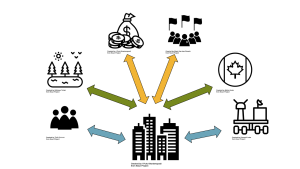
“Business and Its Environment” sums up the relationship between a business and the external forces that influence its activities. One industry that’s clearly affected by all these factors is the fast-food industry. Companies such as Taco Bell, McDonald’s, Tim Hortons and others all compete in this industry. Here are a few statements to show the way external factors impact business. For instance, a strong economy means people have more money to eat out. Food standards are monitored by a government agency, the Canadian Food and Drug Inspection Agency at the federal level with entities at both the provincial and municipal levels following through with adherence. Preferences for certain types of foods are influenced by consumer trends (fast food companies are being pressured to make their menus healthier).
While the type, size, scope, location, purpose, and mission of an organization all help determine the external environment in which it operates, it still must meet the requirements and contingencies of that environment to survive and prosper. It is important to consider how organizations fit with their external environments and how organizations are structured to meet challenges and opportunities of these environments.
The big picture of an organization’s external environment, also referred to as the general environment, is an inclusive concept that involves all outside factors and influences that impact the operation of a business that an organization must respond or react to in order to maintain its flow of operations (Johns & Cena, 2016). Figure 8.2.2 illustrates types of general macro environments and forces that are interrelated and affect organizations: sociocultural, technological, economic, government and political, natural disasters, and human-induced problems that affect industries and organizations.
For example, economic environmental forces generally include such elements in the economy as exchange rates and wages, employment statistics, and related factors such as inflation, recessions, and other shocks—negative and positive. Hiring and unemployment, employee benefits, factors affecting organizational operating costs, revenues, and profits are affected by global, national, regional, and local economies. Other factors that interact with economic forces include politics and governmental policies, international wars, natural disasters, technological inventions, and sociocultural forces. It is important to keep these dimensions in mind when studying organizations since many if not most or all changes that affect organizations originate from one or more of these sources—many of which are interrelated.
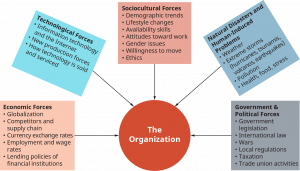
Globalization is a combination of external forces shaping environments of organizations. This dimension continues to present opportunities and pressures for companies operating locally as well as globally.
Organizations and industries are continuously facing new and challenging external environmental demands. Exceptional companies such as Amazon, Spotify, and Google/Alphabet Inc. exemplify evolving business models that combine strategic innovation, technological prowess, and organizational cultural agility that not only meet external environmental demands, but also shape them.
Many businesses with traditional business models, however, have failed or are not succeeding strategically, operationally, and organizationally by not realizing and/or adapting to changing external environments. Such firms that were once successful but did not anticipate and adapt to such changes include Blockbuster, Toys R Us, Borders, Sun Microsystems, Motorola, Digital Equipment Corporation, Polaroid, and Kodak, to name only a few. We have seen the demise of numerous organizations during the Covid-19 pandemic; retailers in particular that did not have an online presence were generally forced to convert, or suffer dire consequences. Technology came to the rescue of many restauranteurs when customers were unable to visit their establishments – companies such as UberEats, SkipTheDishes, and DoorDash found the upside of the pandemic. We are now dealing with challenges brought on by Russia’s war on Ukraine – the repercussions of which have impacted many sectors.
A sample of additional external environmental forces that currently challenge organizations’ survival includes:
- Digital technologies and artificial intelligence (AI): Extensions of AI help automate a firm’s value chain, thus speeding up and increasing efficient operations and service to customers—as Amazon exemplifies. Recent events involving cyberattacks and large-scale manipulation show the security risks to stakeholders, and offer a reminder that environments must be scanned and threats minimized when firms incorporate new digital and online technologies.
- Sharing-economy business models. These organizations use information technologies to gain competitive advantage. Companies such as Airbnb and Uber have ushered in new business models that have already disrupted real estate, hotel, taxi, and other industries. This trend has already had both positive and disruptive effects on companies.
- Shifts in learning and learning credentials. Identifying, recruiting, and retaining talent is crucial to organizations. An evolving crisis for the current generation, our future talent, is the continued rise in higher educational institutions’ tuitions, student debt, and the changing nature of jobs. While bachelor’s degrees remain a requirement for many companies hiring needed higher-level talent, online resources such as Khan Academy, Udacity, and Coursera are gaining recognition and legitimacy toward providing financially challenged students opportunities for entry-level jobs. While many higher-skilled students and professionals may not presently be included in this trend, companies seeking to pay lower wages while offering flexible working conditions are attracting students (Young Entrepreneurship Council, 2018).
- Ethics, corporate social responsibility (CSR), and sustainability. Corruption, lying, and fraud have been and continue to be part of the landscape of governments and public- and private-sector corporations. Public awareness through social and online media has awakened consumers and corporations to the impending dangers and drawbacks of illegal and unethical business activities. Environmental problems such as pollution and climate change pressure companies to be responsible for their share of the costs associated with these problems.
This small sample of powerful external forces illustrates the continuing pressure companies encounter to innovate in their industries. Basic theories, concepts, and principles are presented in this chapter to help explain elements of external environments and how organizations and corporations can organize and are organizing to survive and thrive in the 21st century.
Internal Structures
A 2017 Deloitte source asked, before answering, “Why has organizational design zoomed to the top of the list as the most important trend in the Global Human Capital Trends survey for two years in a row?” (Rahnema & Van Durme, 2017). The source continued, “The answer is simple: The way high-performing organizations operate today is radically different from how they operated 10 years ago. Yet many other organizations continue to operate according to industrial-age models that are 100 years old or more” (ibid).
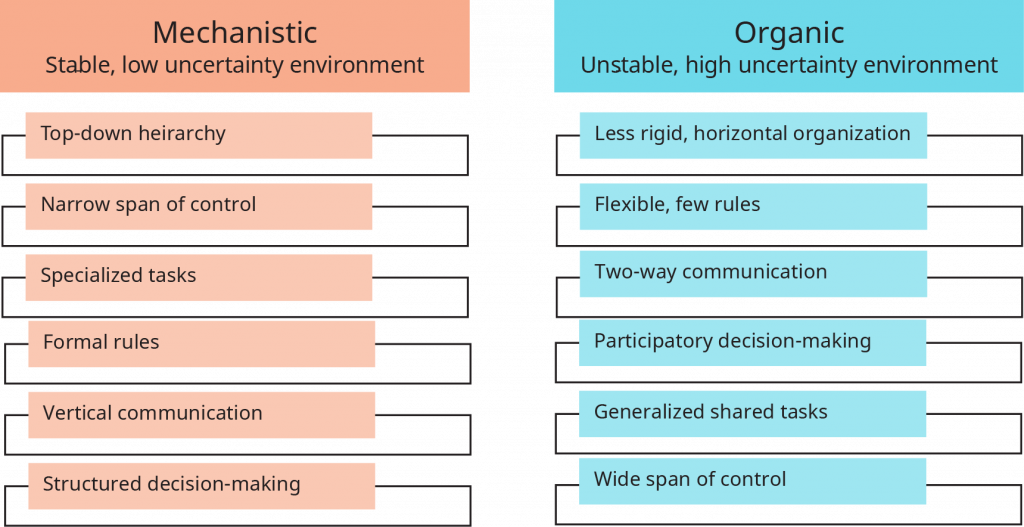
Organic organizational structures and systems, however, have opposite characteristics from mechanistic ones. These organizational forms work best in unstable, complex, changing environments. Their structures are flatter, with participatory communication and decision-making flowing in different directions. There is more fluidity and less-rigid ways of performing tasks; there may also be fewer rules. Tasks are more generalized and shared; there is a wider span of control (i.e., more people reporting to managers). Figure 8.2.3 offers examples of organically structured industries, such as high tech, computer, aerospace, and telecommunications industries, that must deal with change and uncertainty. Contemporary corporations and firms engaged in fast-paced, highly competitive, rapidly changing, and turbulent environments are becoming more organic in different ways, as we will discuss in this chapter. However, not every organization or every part of most organizations may require an organic type of structure. Understanding different organizational designs and structures is important to discern when, where, and under what circumstances a type of mechanistic system or part of an organization would be needed. The following section discusses five types of structures with variations.
Types of Organizational Structures
The six types of organizational structures discussed here include functional, divisional, geographic, matrix, networked/team, and virtual (Burton & Obel, 2018; Daft, 2016; Rahnema & Van Durme, 2017).
Functional Structure
The functional structure, shown in Figure 8.2.4, is among the earliest and most used organizational designs. This structure is organized by departments and expertise areas, such as R&D (research & development), production, accounting, and human resources. Functional organizations are referred to as pyramid structures since they are governed as a hierarchical, top-down control system. Small companies, start-ups, and organizations working in simple, stable environments use this structure, as do many large government organizations and divisions of large companies for certain tasks.

Divisional Structure
Divisional structures are, in effect, many functional departments grouped under a division head. Each functional group in a division has its own marketing, sales, accounting, manufacturing, and production team. This structure resembles a product structure that also has profit centers. These smaller functional areas or departments can also be grouped by different markets, geographies, products, services, or other whatever is required by the company’s business. The market-based structure is ideal for an organization that has products or services that are unique to specific market segments and is particularly effective if that organization has advanced knowledge of those segments.
The advantages of a divisional structure include the following: each specialty area can be more focused on the business segment and budget that it manages; everyone can more easily know their responsibilities and accountability expectations; customer contact and service can be quicker; and coordination within a divisional grouping is easier, since all the functions are accessible. The divisional structure is also helpful for large companies since decentralized decision-making means that headquarters does not have to micromanage all the divisions. The disadvantages of this structure from a headquarters perspective are that divisions can easily become isolated and insular from one another and that different systems, such as accounting, finance, sales, and so on, may suffer from poor and infrequent communication and coordination of enterprise mission, direction, and values. Moreover, incompatibility of systems (technology, accounting, advertising, budgets) can occur, which creates a strain on company strategic goals and objectives.
Geographic Structure
A geographic structure, Figure 8.2.5, is another option aimed at moving from a mechanistic to more organic design to serve customers faster and with relevant products and services; as such, this structure is organized by locations of customers that a company serves. This structure evolved as companies became more national, international, and global. Geographic structures resemble and are extensions of the divisional structure.
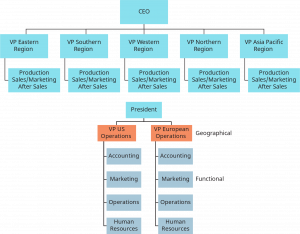
The main downside of a geographical organizational structure is that it can be easy for decision-making to become decentralized, as geographic divisions (which can be hundreds if not thousands of miles away from corporate headquarters) often have a great deal of autonomy.
Matrix Structure
Matrix structures, depicted in Figure 8.2.6, move closer to organic systems in an attempt to respond to environmental uncertainty, complexity, and instability. The matrix structure actually originated at a time in the 1960s when U.S. aerospace firms contracted with the government. Aerospace firms were required to “develop charts showing the structure of the project management team that would be executing the contract and how this team was related to the overall leadership structure of the organization.” As such, employees would be required to have dual reporting relationships—with the government and the aerospace company (Durbin, 2016). Since that time, this structure has been imitated and used by other industries and companies since it provides flexibility and helps integrate decision-making in functionally organized companies.
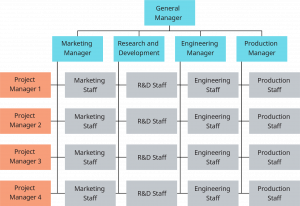
As Figure 8.2.6 illustrates, this structure has lines of formal authority along two dimensions: employees report to a functional, departmental boss and simultaneously to a product or project team boss. One of the weaknesses of matrix structures is the confusion and conflicts employees experience in reporting to two bosses. To work effectively, employees (including their bosses and project leaders) who work in dual-authority matrix structures require good interpersonal communication, conflict management, and political skills to manage up and down the organization.
Different types of matrix structures, some resembling virtual team designs, are used in more complex environments (n.a., 2018). For example, there are cross-functional matrix teams in which team members from other organizational departments report to an “activity leader” who is not their formal supervisor or boss. There are also functional matrix teams where employees from the same department coordinate across another internal matrix team consisting of, for example, HR or other functional area specialists, who come together to develop a limited but focused common short-term goal. There are also global matrix teams consisting of employees from different regions, countries, time zones, and cultures who are assembled to achieve a short-term project goal of a particular customer. Matrix team members have been and are a growing part of horizontal organizations that cut across geographies, time zones, skills, and traditional authority structures to solve customer and even enterprise organizational needs and demands.
As part of the next discussed organizational type of structure, networked teams, organizational members in matrix structures must “learn how to collaborate with colleagues across distance, cultures and other barriers. Matrix team members often suffer from the problem of divided loyalties where they have both team and functional goals that compete for their time and attention, they have multiple bosses and often work on multiple teams at the same time. For some matrix team members this may be the first time they have been given accountability for results that are broader than delivery of their functional goals. Some individuals relish the breath and development that the matrix team offers and others feel exposed and out of control.” To succeed in these types of horizontal organizational structures, organizational members “should focus less on the structure and more on behaviors” (ibid).
Network Structure
Networked team structures are another form of the horizontal organization. Moving beyond the matrix structure, networked teams are more informal and flexible. “[N]etworks have two salient characteristics: clustering and path length. Clustering refers to the degree to which a network is made up of tightly knit groups while path lengths is a measure of distance—the average number of links separating any two nodes in the network” (Satell, 2015).A more technical explanation can be found in this footnote source (Satell, 2010). For our purposes here, a networked organizational structure is one that naturally forms after being initially assigned. Based on the vision, mission, and needs of a problem or opportunity, team members will find others who can help—if the larger organization and leaders do not prevent or obstruct that process.
There is not one classical depiction of this structure, since different companies initially design teams to solve problems, find opportunities, and discover resources to do so. Stated another way, “The networked organization is one that is connected together by informal networks and the demands of the task, rather than a formal organizational structure. The network organization prioritizes its ‘soft structure’ of relationships, networks, teams, groups and communities rather than reporting lines” (Rahnema & Van Durme, 2017). Figure 8.2.7 is a suggested illustration of this structure.
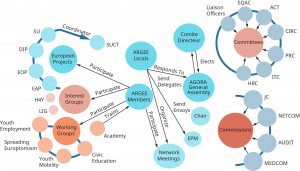
Advantages of networked organizations are similar to those stated earlier with regard to organic, horizontal, and matrix structures. Weaknesses of the networked structure include the following:
(1) Establishing clear lines of communication to produce project assignments and due dates to employees is needed.
(2) Dependence on technology—Internet connections and phone lines in particular—is necessary. Delays in communication result from computer crashes, network traffic errors and problems; electronic information sharing across country borders can also be difficult.
(3) Not having a central physical location where all employees work, or can assemble occasionally to have face-to-face meetings and check results, can result in errors, strained relationships, and lack of on-time project deliverables (Handy, 1995; Ahuja & Carley, 1998).
Virtual Structure
Virtual structures and organizations emerged in the 1990s as a response to requiring more flexibility, solution-based tasks on demand, fewer geographical constraints, and accessibility to dispersed expertise (Onley, 2015). Virtual structures are depicted in Figure 8.2.8. Related to so-called modular and digital organizations, virtual structures are dependent on information communication technologies (ICTs).
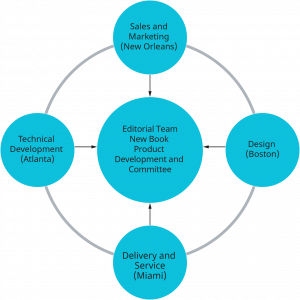
These organizations move beyond network team structures in that the headquarters or home base may be the only or part of part of a stable organizational base. Otherwise, this is a “boundary-less organization.” Examples of organizations that use virtual teams are Uber, Airbnb, Amazon, Reebok, Nike, Puma, and Dell. Increasingly, organizations are using different variations of virtual structures with call centers and other outsourced tasks, positions, and even projects.
Advantages of virtual teams and organizations include cost savings, decreased response time to customers, greater access to a diverse labor force not encumbered by 8-hour workdays, and less harmful effects on the environment. “The telecommuting policies of Dell, Aetna, and Xerox cumulatively saved 95,294 metric tons of greenhouse gas emissions last year, which is the equivalent of taking 20,000 passenger vehicles off of the road” (McCarthy et al., 2010). Disadvantages are social isolation of employees who work virtually, potential for lack of trust among employees and between the company and employees when communication is limited, and reduced collaboration among separated employees and the organization’s officers due to lack of social interaction.
Next, we turn to internal organizational dimensions that complement structure, and are affected by and affect external environments.
“External Factors that Influence Business Activities” in NSCC Fundamentals of Business by NSCC, Pamplin College of Business and Virgina Tech Libraries is licensed under a Creative Commons Attribution-NonCommercial-ShareAlike 4.0 International License, except where otherwise noted.
“Introduction“, “The Organization’s External Environment” and “Organizational Designs and Structures” in Principles of Management by OpenStax and is licensed under Creative Commons Attribution 4.0 International License.

